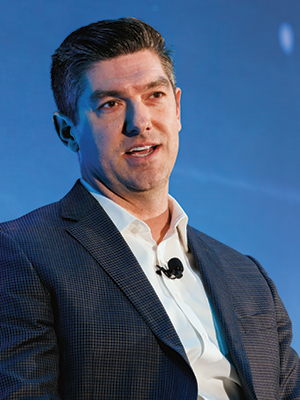The NACS State of the Industry Summit session “Navigating the New Era of Retail Fuel Management” consisted of a conversation between Jeff Burrell, NACS vice president of retail engagement, and Nathaniel Doddridge, vice president of fuels for Casey’s General Stores.
The discussion covered the ins and outs of fuel retailing.
Doddridge joined the Casey’s team in August 2017. He leads the strategy and execution for all facets of fuel including supply, transportation, retail and commercial. Prior to Casey’s, he held several leadership positions across fuel and operations over 13 years at Murphy USA.
The first issue raised was the current world of higher-than-average retail margins. Doddridge noted that after a bit of research, he determined that there were many months between 2012 and 2015 when margins were single digit to 15 cents.
“It feels pretty good that I’m finally a relevant category in my company,” Doddridge joked. “When I got there in 2017 no one really cared that much about fuel margins.”
Blending the Forecourt with the Store
A challenge as old as the industry is maximizing the profit centers on the real estate. How do you leverage pump marketing, digital marketing, the app, location services—those types of things—and try to drive that customer from that pump into the store?
“You have a lot of customers who just go in the store and never go to the pump, and you have a lot of customers that go to the pump and never go in the store,” Doddridge said. He noted that Casey’s has a very good walk-in rate, although “I would imagine probably 100% of the people that pull up at the pump at a Buc-ee’s walk into the store.”
I think we’ve seen more volatility in the last three years than I’ve probably seen in the first 17 years of my career.”
Casey’s is having richer conversations about how all aspects of business can work together. For example, not just look at fuel in a silo and ask, “What’s my margin?” but “What’s the prepared food margin and how do you blend that to try to get the most value out of the basket?”
It’s a trend throughout the industry, and one noted by other speakers at the Summit. The idea of gasoline luring the customer to the site and then the store being an opportunity for incremental sales is giving way to a reality where the store attracts the customer who then also fuels up.
The Brand
The pros and cons of the big oil brands versus the independent brands is another long-standing debate in the industry.
“We see ourselves as a brand. So, we sell unbranded fuel; we don’t fly a major oil brand on our canopies. And I don’t think we can forget that over 60% of the locations in our industry are single stores to less-than-10-store operators,” Doddridge said. “Can someone [of this size] stand on their own two feet with their brand, their backcourt brand being their only brand? I think probably so. There are some very innovative people out there.”
That said, he noted that the brands can help operators who need some support, access to capital, promotional programs and so on.
 Jeff Burrell, NACS VP of retail engagement
Jeff Burrell, NACS VP of retail engagement
Fuel Supply
The post-Covid world is very different from pre-Covid from the fuel supply perspective. Doddridge described the current market.
“I think we’ve seen more volatility in the last three years than I’ve probably seen in the first 17 years of my career. So, you think about being in tune with all the things that you didn’t have to be in tune with previously—refining capacity, disruption—those types of things. They’re super important. As refinery capacity continues to compress, it makes that issue bigger and bigger and bigger.”
He noted the impact of the export market on diesel, which is an important, high-volume product for Casey’s. The supply dynamics make any hiccups super impactful.
 Nathaniel Doddridge, vice president of fuels for Casey’s General Stores
Nathaniel Doddridge, vice president of fuels for Casey’s General Stores
“Coming out post-Covid, the amount of production that went to renewable diesel [has had an impact]. In the grand scheme of things maybe that’s not a ton, but those little changes in reducing refining capacity are really impacting, especially when that product is not absorbed locally,” Doddridge said.
He noted that success goes back to having a really good fuel team with the right people who know how to negotiate and partner with the right people.
“What’s the one thing that’s more important than price—supply reliability,” said Doddridge. “It doesn’t matter what your price is if you don’t have a product to sell.”
Fuel Products
It’s easy to think of fuel in traditional terms—three grades of gasoline and diesel. But times have changed.
I normally have three or four products per store. But if you look across our 17 states, we have almost 40 SKUs, whether that’s different premium blends, ethanol blends, biodiesel blends, kerosene, DEF—things like that,” Doddridge said. “It’s become more and more complex, especially for us as we’ve seen this change of higher ethanol blends. Iowa, for instance, is moving to a mandated 15% ethanol.”
He stated that Casey’s is concentrating on E15 and biodiesel, which receive strong support from both government entities and consumers in corn-belt states, However, those products can require consumer education in less agricultural markets.
Success goes back to having a really good fuel team.
“Living in Iowa, the Field of Dreams was, if you build it, they will come,” Doddridge said. “That is not necessarily the case when you put a product in the market. We’ve had to be good in how we talk about E15. Customers want something that’s reliable, cost efficient and that’s not going to blow their cars up.”
He noted Casey’s has been successful in its messaging and now offers E15 in all the 17 states it operates.
EV Charging
Casey’s offers charging in 37 locations and is very involved in the National Electric Vehicle Infrastructure Formula (NEVI) funding program. However, the company is taking a cautious approach.
Doddridge noted an insight from a visit to Norway, where EV ownership is dominant. Even though 50% of the cars being driven are EVs, they only account for something like 10% of the miles driven, indicating they are likely being used more as a second car than the primary family vehicle.
“We have slowly been moving into [the EV] space. About 0.7% of the registrations in our market are for EVs, so there’s still a long way to go. We’re moving on it, but we’re just not going to move at the speed of light,” Doddridge said.